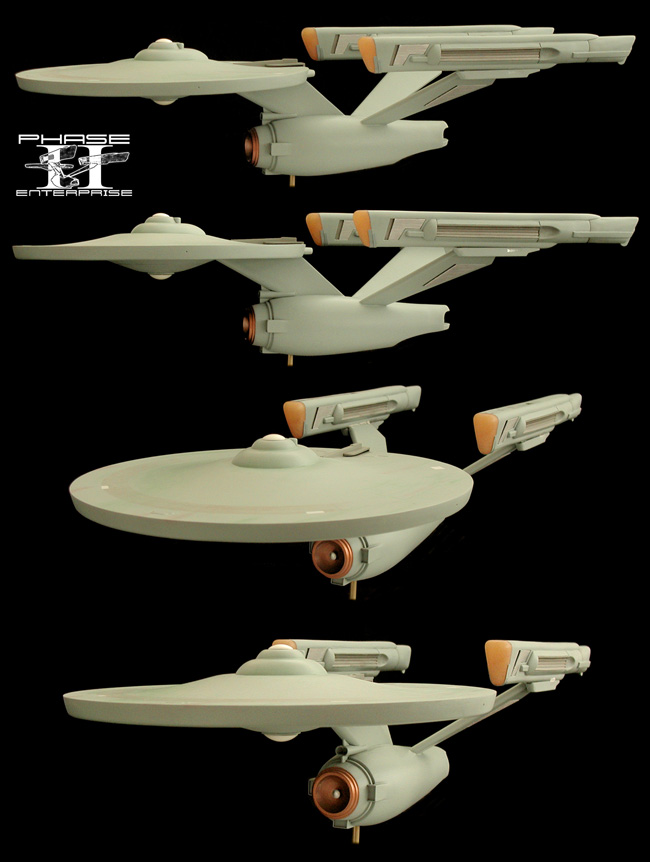-
Welcome! The TrekBBS is the number one place to chat about Star Trek with like-minded fans.
If you are not already a member then please register an account and join in the discussion!
You are using an out of date browser. It may not display this or other websites correctly.
You should upgrade or use an alternative browser.
You should upgrade or use an alternative browser.
Phase II Enterprise Study Model
- Thread starter Shaw
- Start date
- Status
- Not open for further replies.
That is where the photon torpedo launcher would end up on the TMP Enterprise, but originally that was the phasers in Phase II.Uhm, Shaw in the Phase II diagram, you have the note "Main Phaser" pointing to the photon torpedo launcher - or - I'm wrong ?!?
Background...
Lets face it... the original Enterprise had no weapons. It wasn't really on anyones minds at the time it was being designed, so it was left off. Jefferies tried to amend this in his writers guide drawings by showing where they might be and the effects people (not always the same people or company from episode to episode) generally attempted to match this.
To fix this Jefferies added a clearly visible phaser bank at the base of the dorsal. This is also included in the Phase II writer's guide description of the Enterprise's weapons which states...
... and our Optical Effect here is "blips or "squirts" of blue phaser fire, which are emitted from the vessel's main strut.
So the definition of what "phasers" are in Phase II covers both the standard beam version and the "Balance of Terror" version (which seemed like what was later called "photon torpedos"). I think this was an attempt to simplify weapons for the writers, where Starfleet ships used "phasers" while Klingons used "disruptors" and so on.At any rate, the Enterprise was finally given a place where all that was to be seen coming from for Phase II.
The turrets all over the ship in TMP and the dedicated use for torpedos of the assembly at the base of the dorsal are all post-Phase II elements. In going from TOS to Phase II, the Enterprise went from no weapons (on the models) to the weapons assembly at the base of the dorsal.
I know most people see that assembly and assume it is for the photon torpedos because that was what it was for in TMP, but in Phase II it was for the phasers (and everything that was covered under the definition of "phasers" for the series).
That is a nice side-by-side comparison, thank you for posting that. And y'know, in looking at it, I guess I never really knew how anemic those Phase II engines look compared to the TOS engines (or the final refit engines, for that matter). The top view makes them look very thin, small, weak and out-of-scale for the rest of the ship. Small wonder they changed them for the final TMP look. Not a bash on your part, Shaw, by any means. Just an observation on the old design as it was originally laid out. You have done a fantastic job reproducing it down to the smallest detail - warts and all! 

And y'know, in looking at it, I guess I never really knew how anemic those Phase II engines look compared to the TOS engines (or the final refit engines, for that matter).
Well, the idea was that you’d have smaller engines that were more powerful. Instead we’ve gone the Excelsior route where the engines tend to get bigger and bigger.
Sure - miniaturization is always favorable. But from an aesthetic POV, I'm not entirely sure if the scale of those particular engines actually work with the rest of the ship. Many would say the case in point (but opposite) of the JJPrise. Not bashing it - it has some positive aspects - but many have said that the scale of those engines is WAY too big for the rest of the ship. Same idea, just in the other direction. Granted, if Trek was in the "real world", aesthetics would be generally irrelevant over function. In this case, however, it is a factor. And since the engines were probably one of the most significant external design changes between Phase II and TMP, I'd surmise that others felt the same way. The modifications were many and served to make it look much more balanced, IMO.
Really wish they had kept more of the red pinstriping, though. That really made it look cool.
Really wish they had kept more of the red pinstriping, though. That really made it look cool.

For the fun of it I modified Jefferies' Phase II diagrams a bit to look like the TOS Writer's Guide diagrams and set them up for a comparison...
I love that too.
I'd like to see that Enterprise and the AMT model, and Kerr's are three layered over each other with FJ's .
I love that too.
I'd like to see that Enterprise and the AMT model, and Kerr's are three layered over each other with FJ's .
Thanks!
Started in on painting the model and got a little more progress done on the display base.

In the shots below I've gotten most of my first coat applied and have started sanding. I'll go back over it again with another coat (or two) and try to get the surface as smooth/even as possible. once I'm happy with the overall paint, I'll weather the model and apply the gloss coats, then add the decals, another gloss coat and finally a matte coat.
Included in the images is the color sample of Behr UL220-15 Frozen Pond (which is the closest match to the original TOS hull color I could get a physical sample of) for reference. The weathering is going to effect the final overall color, so I mainly wanted to be pretty close to begin with.
The other thing of note in those images is the marker light on the side of the primary hull. That took a while to come up with something I was happy with, but was worth the effort.
Started in on painting the model and got a little more progress done on the display base.

In the shots below I've gotten most of my first coat applied and have started sanding. I'll go back over it again with another coat (or two) and try to get the surface as smooth/even as possible. once I'm happy with the overall paint, I'll weather the model and apply the gloss coats, then add the decals, another gloss coat and finally a matte coat.
Included in the images is the color sample of Behr UL220-15 Frozen Pond (which is the closest match to the original TOS hull color I could get a physical sample of) for reference. The weathering is going to effect the final overall color, so I mainly wanted to be pretty close to begin with.
The other thing of note in those images is the marker light on the side of the primary hull. That took a while to come up with something I was happy with, but was worth the effort.
Truly beautiful. I love this version of the Enterprise, and you're doing her magnificently.
I'm glad to see the orange bussards too. I've seen a few takes where they were either left plain or they were done in a blue, and it just doesn't feel right if they're not red/orange/maroon.
I'm glad to see the orange bussards too. I've seen a few takes where they were either left plain or they were done in a blue, and it just doesn't feel right if they're not red/orange/maroon.

There's just something very early-to-mid-70s about the Phase II Enterprise. It does look more like a literal "refit" of the TOS Enterprise, but aesthetically, what the franchise needed was a bolder statement, and the refit delivered. IMHO, the PII Enterprise would have been satisfactory on a weekly series, but the refit is a work of art, and only the refit could have been able to properly "sell" the sense of awe and majesty in the various beauty-passes as it was mated with Goldsmith and Horner's music.
I'm glad to see the orange bussards too.
This is one of the neatest revelations for me.

Thanks guys!
But all of Jefferies' drawings seem to include them that I can tell. They are a bit more refined by the final plans for the model though.
I've done a little more painting, some weathering and started attaching the nacelles to the pylons.
Okay, another quick-n-dirty test assembly. Things are mostly set or taped in place... just with less tape now that the nacelles can sorta hold themselves up now.
After I took those shots I put her back to rest upside-down. I'm pretty sure the attachments have cured, but we'll give it a while before having her stand on her own for any great length of time.
I know I left them off many of my drawings because I knew they were a feature I'd need to add on later (and Price/Loos were doing the same thing). I focused on the major elements that I knew I needed to include on my master, and less on the elements that were going to be added to the final nacelles.Hey Shaw, I thought some of the plans indicated the nacelle "chin guard" bits were to be omitted. Am I misremembering?
But all of Jefferies' drawings seem to include them that I can tell. They are a bit more refined by the final plans for the model though.
I've done a little more painting, some weathering and started attaching the nacelles to the pylons.
Okay, another quick-n-dirty test assembly. Things are mostly set or taped in place... just with less tape now that the nacelles can sorta hold themselves up now.
After I took those shots I put her back to rest upside-down. I'm pretty sure the attachments have cured, but we'll give it a while before having her stand on her own for any great length of time.
That looks great!
Wow, thanks guys!
I had continued to collect data since then and was getting ready to start reevaluating where I was at on this when Brick Price contacted me. That is what moved this project from being something I might start working on to one of my main projects.
Still, I didn't know the Phase II design as well as the TOS design and I didn't want to bother Price with questions that I could have (and should have) learned on my own. I favor active learning, so I decided to build a study model (this model) using what I had of Jefferies' work to learn the design.
The thing about the Phase II Enterprise is that this was where Jefferies revisited many of his old ideas or ideas that couldn't be implemented on the TOS Enterprise because of cost. For example, Jefferies didn't really like the cylindrical warp engines of the TOS Enterprise, and wanted to change them by the time the series was going to air in 1966 (almost two years after the Enterprise models had been built). The answer he got was no... the models were expensive and that kind of change would cost too much, plus they had already spent a ton of money shooting stock footage of the models during the filming of Where No Man Has Gone Before. Jefferies would later use his engine ideas in the third season of TOS on the Klingon Battle Cruiser.
But you were asking about the deflector dish, so lets look at just the evolution of that part of the Enterprise.
When Jefferies sold Roddenberry on the Enterprise design that we know today, this is what was on the page...

This was a much smaller Enterprise and the primary hull was to land (much like the C-57D in Forbidden Planet). After a number of refinements, this is what was finally approve by Roddenberry for Jefferies to start making plans of for the model builders...

And this is a segment of those final plans...

As you can see, no deflector dish. Jefferies, being an aviation fan, had all that equipment behind a nose cone much like how we have it on jet planes today. He felt that as little of the equipment should be outside the ship as possible.
At the last minute (October of 1964) Roddenberry decided that the Enterprise was too small and asked Jefferies to scale her up (to her final size). He also asks for some additional details on the model and something to help bring the model to life (by adding movement). This is when the deflector dish was added/exposed. The design called for the deflector dish to be able to move and point, which is why the final plans of the Enterprise have a hinge behind the deflector (which was built into the model as well).

Well, as you know, this was never used. Eventually the Enterprise got movement via the lighting effects in the nacelles, but the deflector dish was static during the original series.
Fast forward to 1977 and Roddenberry asks Jefferies to upgrade the Enterprise design. Jefferies didn't want the dish originally, so he pulled it back into the rest of the assembly to make a unified piece of equipment.

Later that design would evolve when Jefferies' plans were used as the foundation of the TMP design and the bowl feature would become transparent (and back lit) and lose the emitter element altogether.
So yeah, the dish wasn't something Jefferies' originally wanted. And when it wasn't originally used as intended he had no problem working the design back towards his original idea.
Update...
I did a little work on the upper surface of the primary hull, I'm still doing a bit of work on the model so I didn't put as many elements in place for this set of shots as before.
What you see on the model is pretty much what you get. A lot of people have attempted to fill in the blanks in Jefferies' plans (often times including elements from TMP) to complete the Phase II Enterprise. I attempted to do a set of plans in 2007 after doing a clean-up project of some of Jefferies plans (which you can find here) but stopped when I realized that I'd be putting too much of my own ideas into the design rather than stay true to Jefferies' vision (and as I didn't work on Star Trek, I shouldn't pollute someone else's creative work by adding in my own). That was why I stopped working on this back then.I've looked at some of the schematics and stuff, but I can't honestly tell. What is the situation with the deflector? Will it have an actual dish or a spoke or anything sticking out there, or is it just pushed back into the stardrive?
I had continued to collect data since then and was getting ready to start reevaluating where I was at on this when Brick Price contacted me. That is what moved this project from being something I might start working on to one of my main projects.
Still, I didn't know the Phase II design as well as the TOS design and I didn't want to bother Price with questions that I could have (and should have) learned on my own. I favor active learning, so I decided to build a study model (this model) using what I had of Jefferies' work to learn the design.
The thing about the Phase II Enterprise is that this was where Jefferies revisited many of his old ideas or ideas that couldn't be implemented on the TOS Enterprise because of cost. For example, Jefferies didn't really like the cylindrical warp engines of the TOS Enterprise, and wanted to change them by the time the series was going to air in 1966 (almost two years after the Enterprise models had been built). The answer he got was no... the models were expensive and that kind of change would cost too much, plus they had already spent a ton of money shooting stock footage of the models during the filming of Where No Man Has Gone Before. Jefferies would later use his engine ideas in the third season of TOS on the Klingon Battle Cruiser.
But you were asking about the deflector dish, so lets look at just the evolution of that part of the Enterprise.
When Jefferies sold Roddenberry on the Enterprise design that we know today, this is what was on the page...

This was a much smaller Enterprise and the primary hull was to land (much like the C-57D in Forbidden Planet). After a number of refinements, this is what was finally approve by Roddenberry for Jefferies to start making plans of for the model builders...

And this is a segment of those final plans...

As you can see, no deflector dish. Jefferies, being an aviation fan, had all that equipment behind a nose cone much like how we have it on jet planes today. He felt that as little of the equipment should be outside the ship as possible.
At the last minute (October of 1964) Roddenberry decided that the Enterprise was too small and asked Jefferies to scale her up (to her final size). He also asks for some additional details on the model and something to help bring the model to life (by adding movement). This is when the deflector dish was added/exposed. The design called for the deflector dish to be able to move and point, which is why the final plans of the Enterprise have a hinge behind the deflector (which was built into the model as well).

Well, as you know, this was never used. Eventually the Enterprise got movement via the lighting effects in the nacelles, but the deflector dish was static during the original series.
Fast forward to 1977 and Roddenberry asks Jefferies to upgrade the Enterprise design. Jefferies didn't want the dish originally, so he pulled it back into the rest of the assembly to make a unified piece of equipment.

Later that design would evolve when Jefferies' plans were used as the foundation of the TMP design and the bowl feature would become transparent (and back lit) and lose the emitter element altogether.
So yeah, the dish wasn't something Jefferies' originally wanted. And when it wasn't originally used as intended he had no problem working the design back towards his original idea.
Update...
I did a little work on the upper surface of the primary hull, I'm still doing a bit of work on the model so I didn't put as many elements in place for this set of shots as before.
- Status
- Not open for further replies.
Similar threads
- Replies
- 25
- Views
- 10K
- Replies
- 87
- Views
- 20K
If you are not already a member then please register an account and join in the discussion!




